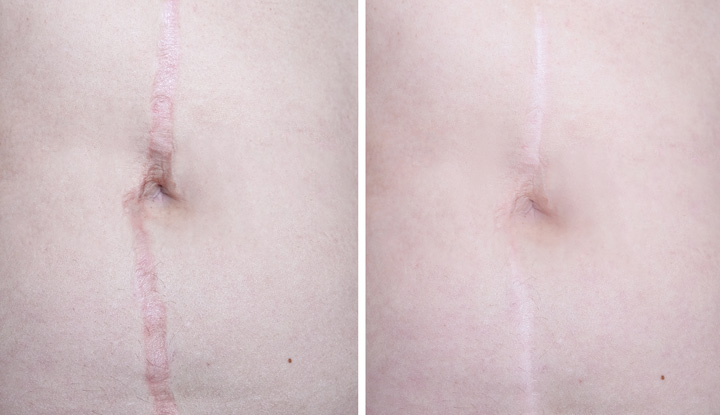Scar revision is a cosmetic or medical treatment to reduce the appearance of or pain associated with a scar. There is a variety of scar revision techniques, ranging from topical skin therapies to scar revision surgery.
Advertisement
Cleveland Clinic is a non-profit academic medical center. Advertising on our site helps support our mission. We do not endorse non-Cleveland Clinic products or services. Policy

Scar revision is a treatment to reduce the appearance of scars, which are marks left on your skin after wounds heal. Scar revision can take several forms, ranging from creams you put on your skin to surgery.
Advertisement
Cleveland Clinic is a non-profit academic medical center. Advertising on our site helps support our mission. We do not endorse non-Cleveland Clinic products or services. Policy
The goal of scar revision is to help your scar more closely match the color and texture of your surrounding skin. But it won’t completely eliminate your scar. Scar revision is usually cosmetic, but sometimes, severe scars are painful or make it hard for your body to function. These scars need medical treatment.
There are many types of scars. They can be thick and raised (hypertrophic scars) or excessively large and lumpy (keloid scars). They may also be flat, discolored or depressed (sunken beneath the surface of your skin). The type, location and cause of your scar are important factors in determining the right scar revision treatment for you.
Anyone who has an unwanted scar may consider scar revision. Some common reasons for scarring include:
Your healthcare provider will tell you how to prepare for scar revision. You may need to:
Advertisement
People with diabetes or those who are taking immunosuppressants may need to follow special instructions before scar revision. Additionally, if you’re taking isotretinoin or other medications for severe acne, you may need to delay treatment while you undergo scar revision. Your healthcare provider can give you additional information about this.
Your healthcare provider will evaluate a variety of factors to determine what type of scar revision is right for your needs. Most scars need 12 to 18 months to mature, as new scars don’t usually respond well to scar revision.
Scar revision techniques may include:
Your provider will apply topical treatments to the surface of your skin, so they don’t require a needle or any type of incision (cut). Topicals tend to be more effective as a wound heals, or for mild, newly formed scars.
Types of topical treatments include:
Most people need to use topical treatments for 12 to 24 hours each day, sometimes, for several months.
Some healthcare providers may recommend vitamin E or A as a cream, gel or oil to treat scars. However, the research on the effectiveness of these treatments is inconclusive.
Your healthcare provider may inject different types of medicine directly into your scar. Injectables are most effective for raised scars and keloids. They can reduce the size of a scar and minimize pain, itching and irritation. Most people need multiple injections.
Types of injections include:
Advertisement
Skin resurfacing treatments work by removing the top layers of your skin. They help reveal smoother, undamaged skin, which can improve the color and texture of scars.
Types of resurfacing treatments include:
Sometimes, surgery is necessary for large, severe scars, especially if the scars are causing you pain or making it difficult to move. During surgery, a healthcare provider cuts the scar out of your skin and then closes the wound with stitches.
Advertisement
Common scar revision surgeries include Z-plasty and W-plasty. A surgeon cuts the scarred skin into a “Z” or “W” formation, which gives that area of skin more movement once it heals.
Some people need skin grafts if there isn’t enough healthy skin to close the wound. A surgeon might use skin from another area of your body. Grafting is a common treatment for serious burn scars.
Your healthcare provider might recommend injections or topical scar treatment to help a new surgical wound heal and reduce the risk of additional scarring.
Risks of scar revision depend on the type of treatment you receive. It’s important to follow post-care instructions from your provider for the best results. Topical treatments tend to carry the fewest risks, which include mild discomfort or skin irritation such as a rash (contact dermatitis).
Injections and resurfacing treatments can lead to redness, swelling, blistering and increased sensitivity to sunlight. They may also change the color of the scar, making it darker than the surrounding skin.
Scar revision surgery tends to carry the most risks, including infection and bleeding. There’s also a chance that the scar will return, or that the surgery will cause a new scar to form.
Advertisement
Scar revision can reduce the appearance of scars and minimize discomfort associated with scars. Treatment can help improve a scar’s:
Recovery after scar revision depends on the type of treatment you receive. Topical treatments can take several months to produce results. Most people need multiple injections or resurfacing treatments to achieve their goal. Recovery after surgery may take weeks or months.
It’s important to keep in mind that scar revision isn’t likely to completely remove the scar. Discuss your goals for treatment with your healthcare provider to ensure you have realistic expectations about the results.
Contact your healthcare provider if you notice your scar or the skin around it is:
Scar revision is a treatment to reduce the appearance of a scar and any discomfort it may be causing. This treatment can take many different forms, including topical skin treatments, injectables, skin resurfacing and surgery. Your healthcare provider will evaluate the severity of your scar, its location and size before building the right treatment plan for your needs.
Not all scars just fade away, and some are hard to hide. At Cleveland Clinic, our experts will create a personalized treatment plan for your unique scars.

Last reviewed on 01/31/2023.
Learn more about the Health Library and our editorial process.